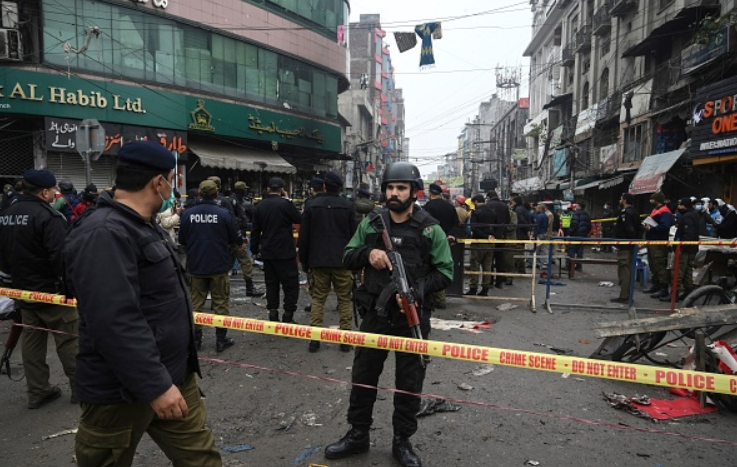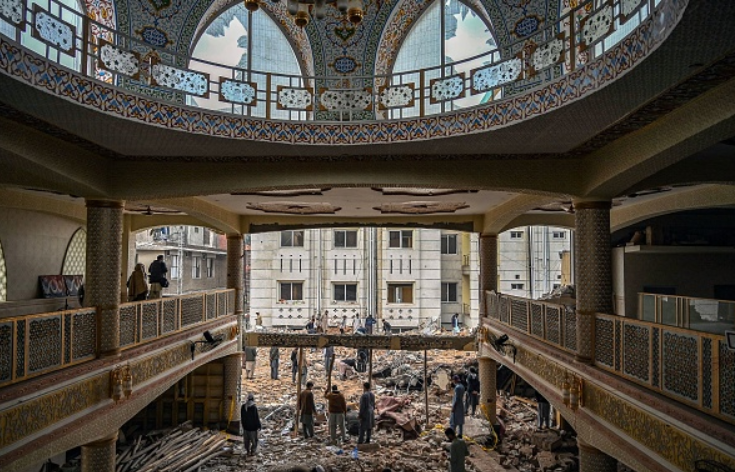
The recent wave of terrorist attacks in Pakistan has reset the clock on counterterrorism efforts. Combing operations and a more comprehensive set of counterterrorism strategies under Radd-ul-Fasaad allowed Pakistan to stem the peak of terrorist activities in 2009. However, these measures face scrutiny once again in the wake of last month’s attacks on a mosque inside a highly fortified police compound in Peshawar and on the Karachi Police Office in the heart of the country’s most populous city. Targeting law enforcement agencies and sensitive installations indicates that terrorist agencies and their associates intend on reversing Pakistan’s counterterrorism success story. Despite having a fully functional and highly operable counterterrorism policy, Pakistan requires a complementary antiterrorism strategy to stave off this threat.
The difference between counterterrorism and antiterrorism is that the latter serves to preempt and prevent terrorism while the former is a more reactionary response post-incident. After an attack, counterterrorism strategies focus on retaliatory and reactionary responses often using punitive military operations and targeting terrorist facilities. Antiterrorism strategies, on the other hand, play out before attacks, employing complex legal and procedural mechanisms to erode sympathy and support for terrorist organizations. Antiterrorism aims to identify and protect sections of society vulnerable to terrorist ideologies by developing legal systems that reestablish and strengthen rule of law. As Pakistan addresses the current influx of terrorism, policymakers must complement counterterrorism mechanisms with a broad-spectrum antiterrorism framework to address root causes.
Identifying the Counterterrorism-Antiterrorism Schism in Pakistan
Pakistan’s first experience with the counterterrorism-antiterrorism schism came following the success of comprehensive military operations launched in 2009. With immediate threats mitigated, the state developed more institutions meant to address the complex root causes driving and enabling terrorism in the country. While intentions were correct, Pakistan has failed to integrate the antiterrorism strategies into existing counterterrorism frameworks.
As Pakistan addresses the current influx of terrorism, policymakers must complement counterterrorism mechanisms with a broad-spectrum antiterrorism framework to address root causes.
The counterterrorism-antiterrorism schism is most starkly seen in the National Action Plan and its subsequent National Counterterrorism Authority (NACTA). Established following the Army Public School (APS) attack in 2014, NACTA aims to preempt root causes of terrorism through a comprehensive policy approach and strategic communication. The idea was to strengthen Pakistan’s ability to create early warning mechanisms and provide sufficient institutional synchronization to deter terrorists from taking advantage of Pakistan’s social, economic, and political vulnerabilities. However, in the years since, NACTA has instead focused on the theoretical assessment of terrorist activities and left law enforcement and legal services isolated from each other. Though NACTA theoretically serves as an ideal institution for addressing terrorism and its various mutations, it has faced severe roadblocks in dealing with terrorism and how terrorist organizations change their focus.
Distinguishing between terrorists and other forms of criminals is one aspect that is consistently overlooked in designing an implementation mechanism for antiterrorist policies. Criminals accused of heinous crimes and sectarian violence are distinct from those apprehended for terrorist activities, but section 7 of the anti-Terrorism Act of 1997, which deals with punishing terrorists has frequently been used on a whole host of non-terrorist criminals. This not only chokes up judicial functioning in legal proceedings against such acts but also floods state law enforcement with investigations that either lead to acquittals due to the unavailability of evidence or engross the actual success of antiterrorist strategies.
Due to the slow civilian legal process, Pakistan established special military courts against apprehended terrorists. However, these military courts recorded a growing number of undecided investigations and faces issues of due process. Parallel civilian and military structures not only undermine Pakistan’s ability to aspire to confidence in the national and international community but also weakens any consolidation of accomplishments of counterterrorism strategies.
Before the 2014 APS attack, the counterterrorism-antiterrorism schism was ever wider. In the post-9/11 period, successful counterinsurgency operations allowed Pakistan to cover vast grounds, but also opened up space for terrorists to retaliate with more force than anticipated, adding another layer to its counterterrorism-antiterrorism approach. Following the APS Peshawar incident, Pakistan prioritized reactive counterterror mechanisms over antiterror strategies, designing a comprehensive counterterrorism policy with multipronged military and intelligence operations.

During this time, Pakistan did less to focus on anti-terrorism efforts. Courts, investigative doctrines, and associated law enforcement agencies were redesigned on military doctrines, a task that does not suffice the requirements of successful antiterrorism practices. As the state prioritized counterterrorism policies in reaction to the attack, kinetic options eclipsed antiterrorism mechanisms. Parliamentary discourse following the attack focused laws and investigative priorities on counterterrorism, which not only diluted established law enforcement mechanisms but also paved the way for puzzling the differences it had with counterterrorism.
As counterterrorism approaches coopted antiterrorism mechanisms over time, institutional redundancies have emerged that undermine Pakistan’s rule of law. For example, separate legal and investigative systems established in response to the APS attack have undermined operability. Civilian agencies like the Federal Investigation Agency and local law enforcement lack the adequate infrastructure to detain militants, which either compels agents to surrender accused persons to the armed forces or deal with security breaches and terrorist attacks on such installations that they have. Military operations, intelligence operations, and combing and sweeping operations against terrorists in conflict regions are some of the many steps in a comprehensive policy. Internal migrations and internal displacements due to counterterrorism operations require comprehensive law enforcement strategies in identifying trends and traits.
Prioritizing Antiterrorism in Pakistan: The Way Forward?
Pakistan is fighting an uphill battle against terrorism. Political instability and local law enforcement in need of reform add to the problem, diminishing the successes of past counterterrorism operations. Attacks on police and local law enforcement installations and paramilitary forces allow terrorists, separatists, and extremists to operate more fluidly in absence of joint integrated operations. The police force in Pakistan has been a subject matter of intense criticism in terms of maintaining security but the fact that the police serve as a bridge between antiterrorist and counterterrorist operations is a feature that remains absent from Pakistan’s National Action Plan.
The recent decisions to fight terrorism in Pakistan refresh old commitments and restate past practices hoping for different results. No new institutional amendments or legal frameworks have been put to practice or set in motion. Counterterrorist forces in Pakistan are well-equipped, maintain exceptional doctrinal and strategic synchronization, and possess abundant social support, but antiterrorist institutions are neither well-equipped nor integrated into the broader narrative, which undermines their operability and preemptive/preventive modus operandi.
The National Action Plan receives sufficient amendments and structural modifications, but it lacks input from local law enforcement in terms of designing policy mechanisms.
The National Action Plan receives sufficient amendments and structural modifications, but it lacks input from local law enforcement in terms of designing policy mechanisms. Pakistan would have to focus on antiterrorism as much as it did on counterterrorism practices because not only would this provide fluidity in operations but will also calibrate integrated operations by multifarious law enforcement agencies in addressing various transitions of terrorist activities and groups in Pakistan. Breaking the nexus between terrorists, separatists, proscribed organizations and criminal entities is an antiterrorism agenda and it cannot be addressed if the same counterterrorism strategies are put to place as a response to recent terrorist activities.
***
Click here to read this article in Urdu.
Image 1: Arif Ali/AFP via Getty Images
Image 2: Abdul Majeed/AFP via Getty Images


